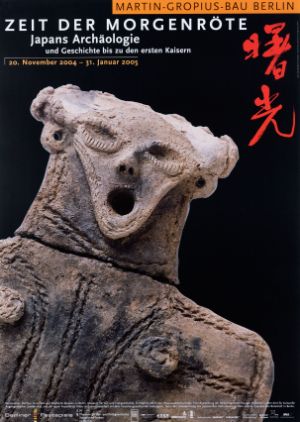Exhibition
Time of Dawn
Japan's Archaeology and History up to the first Emperors

Poster of the exhibition “Time of Dawn. Japan's Archaeology and History up to the first Emperors” Design: Steenbrink Vormgeving, Berlin
About the Exhibition
An exhibition is devoted worldwide for the first time to the entire early history of the Japanese island chain, from the earliest evidence of settlements to the first palaces of the Japanese emperors.
The Reiss-Engelhorn Museums of Archaeology and Ethnology in Mannheim took the initiative and conceived the exhibition over a period of many years together with one of the curators who also worked in Japan.
Agreements reached with the most important museums and collections of Japan have made it possible to bring this eminent exhibition to Germany.
After years of preparation, the biggest and most comprehensive exhibition on the pre- and early history of Japan ever to be put together will be presented in the Martin-Gropius-Bau. An exhibition of this dimension has never been undertaken in Japan or anywhere else in the world. It is unlikely that such an extensive total survey of Japanese archaeological research will be seen again in the near future.
The exhibition covers the period from the earliest settlement of the Japanese islands at least 40,000 years ago up to the introduction of Buddhism in the 6th century and the Asuka and Nara period (7th/8th century AD) with its great palaces.
Around 1500 objects from 55 different Japanese museums and institutions will be displayed – most of which have never been shown outside of Japan before, including national treasures and objects classified as important cultural heritage of the nation.
With its research findings Japanese archaeology is among the most modern of its kind in the world and has had unprecedented success since the war. This exhibition takes stock of the research results and the spectacular finds of the post-war period which have previously not been taken into account and remained largely unknown beyond the country’s own borders, although they have become an important factor for the historical understanding and self-perception of present-day Japan. Upheavals and continuities form a further focus of the exhibition.
Arrangement of the exhibition
- Prologue. The birth of the Japanese world.
The period from 40,000 to 12,000 BC - The oldest ceramics of the world. The life of the hunter and gatherer culture.
Jômon period (10,000 BC to 500 BC) - The age of rice cultivation begins. Complex communities develop.
Yayoi period (5th to 3rd centuries BC) - Awakening of the socially structured society. The period of the keyhole-shaped burial mounds.
Kofun period (3rd century BC to 7th century AD) - Epilogue: Far-reaching changes.
Buddhism prevails. The court society develops.
Asuka period, Nara period (7th/8th century) - Outlook: continuity and change.
Jewellery and clothing from the Jômon period to the Nara period: Japanese archaeology today
Archaeology in Japan – the Past in the Present
Present-day Japan is marked by technological progress and economic expansion as well as by the immediate confrontation with a tradition whose roots reach far back into archaic times. This is evident not least of all in the extent and importance given to the science of archaeology in Japan today. With its research findings Japanese archaeology is among the most modern of its kind in the world and has had unprecedented success since the war, with tens of thousands of excavations and innumerable objects having been found.
Organizer: Berliner Festspiele and Reiss-Engelhorn-Museen, Mannhein.
Made possible by the Hauptstadtkulturfonds Berlin.
With support from the Japan Foundation, the Office of Cultural Affairs (Bunkacho) and the Japanese Embassy in Berlin. In cooperation with the Research Institute of Cultural Properties, Nara.
Curators: Alfried Wieczorek, Mannheim with Werner Steinhaus, Tokyo
Venues: Mannheim: Reiss-Engelhorn-Museen, Berlin: Martin-Gropius-Bau, Nara (Japan): National Museum